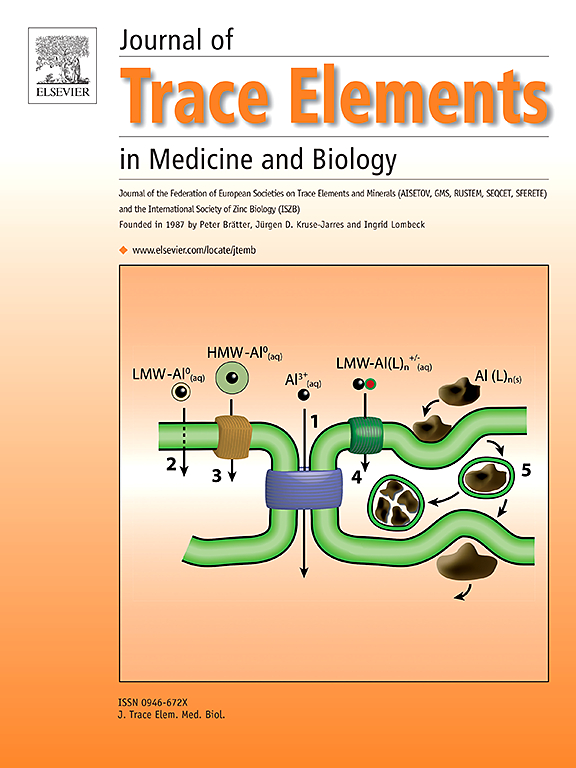Iodine intakes of pregnant females from Québec, Canada
IF 3.6
3区 医学
Q2 BIOCHEMISTRY & MOLECULAR BIOLOGY
Journal of Trace Elements in Medicine and Biology
Pub Date : 2025-01-17
DOI:10.1016/j.jtemb.2025.127601
引用次数: 0
Abstract
Background
Adequate maternal iodine intake is important for fetal brain development. Based on iodine intakes of non-pregnant females of reproductive age from the Canadian Health Measures Survey (2016 −2017) it can be extrapolated that most pregnant females in Canada will not meet iodine requirements without supplementation.
Objectives
To assess iodine intakes of 500 pregnant, nulliparous females from Québec, Canada and report on use of multivitamin/mineral (MVM) supplements and coverage of iodized salt.
Methods
Duplicate spot urine samples were collected at 10.1 −14.9 weeks (T1) and 19.7 −24.9 weeks (T2) of gestation. Median urinary iodine concentrations (UIC) were compared with WHO/UNICEF/ICCIDD reference ranges. Daily iodine intakes were calculated from UIC using a formula that corrects for urine dilution using creatinine and accounts for urinary iodine excretion rate. Usual (adjusted for within-person variation) iodine intakes were estimated from duplicate daily intake measurements (T1 and T2 measures) using the National Cancer Institute method. Prevalence of inadequate or excessive intakes were determined from usual intakes by the Estimated Average Requirement (EAR) or Tolerable Upper Intake Level (UL) cut-point method, respectively.
Results
Females (median: 30.1 years) were mostly white race (94.4 %), highly educated and consumed iodized salt (92 %). Median UIC at T1 (136 µg/L, IQR: 71 −230) was lower (p<0.001) than at T2 (193 µg/L, IQR: 112 −390). Almost all females used a MVM supplement (98.2 %) with 35.6 % starting supplementation preconception and 0.6 %, 28.4 %, 19.8 %, 7.2 % and 6.0 % starting 1 −2 weeks, 3 −4 weeks, 5 −8 weeks, 8 −12 weeks and > 12 weeks postconception, respectively. Almost all (99 %, 95 % CI: 98, 100) had usual iodine intakes ≥EAR and ≤UL.
Conclusions
Prevalence of inadequate or excessive usual iodine intakes was low. However, about two-thirds of females started MVM supplementation postconception and median UIC at T1 was below the adequate range of 150 −249 µg/L.
加拿大魁梅茨孕妇的碘摄入量。
背景:充足的母体碘摄入量对胎儿大脑发育非常重要。根据加拿大健康措施调查(2016 -2017)中未怀孕育龄女性的碘摄入量可以推断,如果不补充碘,加拿大大多数怀孕女性将无法满足碘需求。目的:评估来自加拿大quacimbec的500名怀孕、未生育女性的碘摄入量,并报告复合维生素/矿物质(MVM)补充剂的使用情况和碘盐的覆盖率。方法:在妊娠10.1 ~ 14.9周(T1)和19.7 ~ 24.9周(T2)采集重复斑点尿样。尿碘中位浓度(UIC)与WHO/UNICEF/ICCIDD参考范围进行比较。每日碘摄入量由UIC计算,使用一个公式,该公式使用肌酐校正尿稀释,并考虑尿碘排泄率。使用国家癌症研究所的方法,通过重复的每日摄入测量(T1和T2测量)来估计通常(根据个人差异进行调整)的碘摄入量。摄入量不足或过量的发生率分别由估计平均需水量(EAR)或可耐受最高摄入量(UL)临界值法确定。结果:女性(中位数:30.1岁)以白人(94.4 %)、高学历和食用碘盐(92 %)为主。妊娠12周后,T1的中位UIC(136 µg/L, IQR: 71 -230)分别较低(p )。几乎所有(99 %,95 % CI: 98, 100)的碘摄入量≥EAR和≤UL。结论:碘摄入量不足或过量的发生率较低。然而,大约三分之二的女性在受孕后开始补充MVM, T1时的中位UIC低于150 -249 µg/L的适当范围。
本文章由计算机程序翻译,如有差异,请以英文原文为准。
求助全文
约1分钟内获得全文
求助全文
来源期刊
CiteScore
6.60
自引率
2.90%
发文量
202
审稿时长
85 days
期刊介绍:
The journal provides the reader with a thorough description of theoretical and applied aspects of trace elements in medicine and biology and is devoted to the advancement of scientific knowledge about trace elements and trace element species. Trace elements play essential roles in the maintenance of physiological processes. During the last decades there has been a great deal of scientific investigation about the function and binding of trace elements. The Journal of Trace Elements in Medicine and Biology focuses on the description and dissemination of scientific results concerning the role of trace elements with respect to their mode of action in health and disease and nutritional importance. Progress in the knowledge of the biological role of trace elements depends, however, on advances in trace elements chemistry. Thus the Journal of Trace Elements in Medicine and Biology will include only those papers that base their results on proven analytical methods.
Also, we only publish those articles in which the quality assurance regarding the execution of experiments and achievement of results is guaranteed.

 求助内容:
求助内容: 应助结果提醒方式:
应助结果提醒方式:


